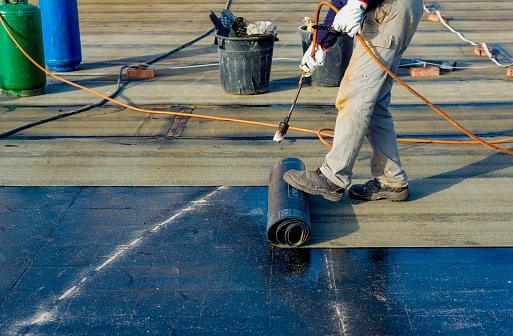
When opting for a new roof, you may decide that a tiled roof would be the best option for you. However, one aspect that is typically not considered when re-tiling your roof is the roof felt. Despite the fact that the tiles may be fine in harsh weather, the roof felt beneath that is layered between the roof and deck can be damaged. So, when deciding to install your new roofing, it’s important to consider the lifespan of both the surface material and the felt underlayer along with the factors which could lower its lifespan.
What is Roof Felt?
Roofing felt is laid on top of the supporting rafters but beneath the roof tiles or slate battens to secure the surface material in place. Roofing felt is often referred to as roofing underlay as it often secures roofing tiles to prevent any shifting that may occur from strong winds. Roof felt also offers some protection from heavy rain, providing an extra barrier between the roof surface and the roof structure, allowing rain to run off the roofs surface without seeping into the internal roof and the home.
Roof felt also adds an extra layer of insulation to your home which prevents any excess heat escaping further. This extra layer allows for a more energy efficient home by keeping the heat inside the home.
Find out more about ‘How much it costs to felt a roof’.
Factors Affecting Roof Felt Lifespan
The lifespan of roof felt can be negatively affected by extreme weather conditions, as previously mentioned. However, there are a few things you can do to lengthen the lifespan of your felt roof:
- Inspect your roof – It’s advisable to get your roof inspected at least once a year for any signs of damage. This will allow you to act on any issues quickly and avoid having to replace your roof.
- Check your roof after extreme weather – Most of the damage to your roof will occur after bouts of extreme weather. That’s why if you check for damage after any extreme storms, considerably high or low temperatures, you may be able to catch and act on any damage early.
- Don’t walk on your roof – To save any further roof degradation, it’s important not to put your roof under any unnecessary stress.
Average Lifespan of Roof Felt
Asphalt felt is the most common type of underlayment and typically has a lifespan of around 20 to 30 years. However, if faced with extreme weather conditions this lifespan can be cut by as much as half. The full lifespan of your roof felt is dependent on the conditions that the roof is exposed to.
There are some modern alternatives to roof felt such as synthetic rubber underlay. These modern alternatives may last longer than roof felt but they also come with a considerably higher upfront cost. Traditional felt is also known to encourage condensation, so other materials that are more breathable sometimes come recommended if your house is at risk of condensation.
Repairing vs. Replacing Roof Felt
There are a few signs that indicate if you need to repair or replace your roof felt. We have collated a list and considered your options:
- Air Bubbles: If you notice air bubbles in your roof felt, you may be able to repair this before the damage gets worse. The repair would be simple if identified early, however if left to worsen the bubbles could grow and pop, causing irreversible damage to the roof felt.
- Water Pooling: If water is left on the felt, it can add significant stress to the roof which could lead to cracking and water penetration. If you notice this in your home, you should contact a professional immediately to see if the roof can be salvaged by repairing a portion of the roof felt. However, if the problem has been worsening over time then replacing the roof could be the only alternative.
- Fractures or Cracks: If you notice fractures or cracks on your roof felt, it could be a clear sign that you need to replace your roof felt. Whilst minor tears can be salvaged through a simple repair, a significant fracture or crack over the entire surface of the felting indicates a replacement is necessary.
- Moss or Mildew Growth: Moss or mildew growth signifies that water has accumulated on your roof. If this is neglected, water damage can occur and cause major complications. This could result in the necessary replacement of the entire roof.
Overall, replacing the entire roof felt can be an expensive job. See a guide here for the cost to refelt a roof. To avoid this, you need to be aware of the condition of your roof felt and act quickly if you notice any signs of degradation.
Conclusion
To summarise, the more you take care of your roof felt the longer it should last. However, if you are ever worried about the condition of your roof felt, you should consult a professional roofer to inspect your roof and determine the correct route of action.
Steven Bennett
Related posts
Stay connected
Today's pick
- Things to Remember While Designing Your Custom Modular Kitchen in GurgaonGurgaon now known as Gurugram is the second largest city in the state of Haryana and is a reflectiossn of an ideal modern city with futuristic goals. Witnessing rapid urbanization, it has also emerged as a hub for contemporary homes, with homeowners seeking innovative and... The post Things to Remember While Designing Your Custom Modular […]
